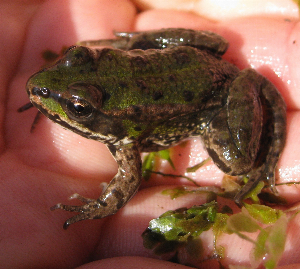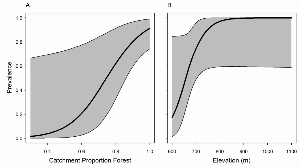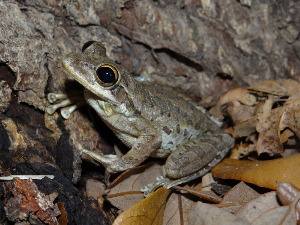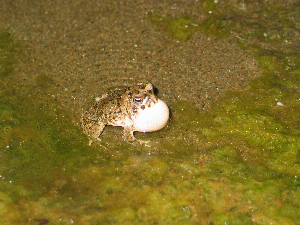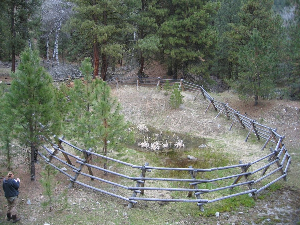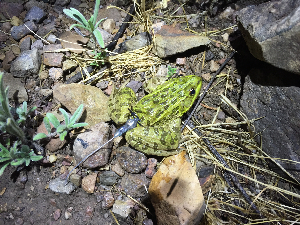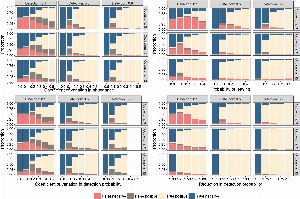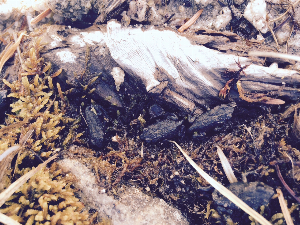Search ARMI Database
Search term(s)
Contribution Number
Search Results
879 record(s) found.
Papers & Reports Chapter 2. Planning and setting objectives in field studies.
Authors: Robert N Fisher
Date: 2016
This chapter enumerates the steps required in designing and planning field studies on the ecology and conservation of reptiles, as these involve a high level of uncertainty and risk. To this end, the chapter differentiates between goals (descriptions of what one intends to accomplish) and objectives (the measurable steps required to achieve the established goals). Thus, meeting a specific goal may require many objectives. It may not be possible to define some of them until certain experiments have been conducted; often evaluations of sampling protocols are needed to increase certainty in the biological results. And if sampling locations are fixed and sampling events are repeated over time, then both study-specific covariates and sampling-specific covariates should exist. Additionally, other critical design considerations for field study include obtaining permits, as well as researching ethics and biosecurity issues.
Papers & Reports Chapter 9. Standard techniques for inventory and monitoring: Reptile sign and camera traps.
Authors: Robert N Fisher
Date: 2012 | Outlet: Reptile Biodiversity: Standard Methods of Inventory and Monitoring
Papers & Reports Chapter 9. Standard techniques for inventory and monitoring: Pitfall-trap surveys.
Authors: Robert N Fisher; Carlton J Rochester
Date: 2012 | Outlet: Reptile Biodiversity: Standard Methods of Inventory and Monitoring
Papers & Reports Chapter 3. Study design and sampling: Overview.
Authors: Robert N Fisher; M J Mitrovich
Date: 2012 | Outlet: Reptile Biodiversity: Standard Methods of Inventory and Monitoring
Papers & Reports Heterogeneous responses of temperate-zone amphibian populations to climate change complicates conservation planning
Authors: Erin Muths; Thierry C Chambert; Benedikt R Schmidt; David AW Miller; Blake R Hossack; Pierre Joly; O Grolet; David E Green; David S Pilliod; Marc Cheylan; Robert N Fisher; Rebecca M McCaffery; Michael J Adams; Wendy J Palen; Jan W Arntzen; Justin Garwood; Gary M Fellers; Jean-Marc Thirion; Aurélien Besnard; Evan HC Grant
Date: 2017-12 | Outlet: Scientific Reports. DOI:10.1038/s41598-017-17105-7
The pervasive and unabated nature of global amphibian declines suggests common demographic responses to a given driver, and quantification of major drivers and responses could inform broad-scale conservation actions. We explored the influence of climate on demographic parameters (i.e., changes in the probabilities of survival and recruitment) using 31 datasets from temperate zone amphibian populations (North America and Europe) with more than a decade of observations each. There was evidence for an influence of climate on population demographic rates, but the direction and magnitude of responses to climate drivers was highly variable among taxa and among populations within taxa. These results reveal that climate drivers interact with variation in life-history traits and population-specific attributes resulting in a diversity of responses. This heterogeneity complicates the identification of conservation ?rules of thumb? for these taxa, and supports the notion of local focus as the most effective approach to overcome global-scale conservation challenges.
Papers & Reports Multiple drivers, scales, and interactions influence southern Appalachian stream salamander occupancy
Authors: K K Cecala; John C Maerz; Brian J Halstead; J R Frisch; T L Gragson; J Hepinstall-Cymerman; D S Leigh; Rhett C Jackson; James T Peterson; Catherine M Pringle
Date: 2018-03-14 | Outlet: Ecosphere
Understanding how factors that vary in spatial scale relate to population abundance is vital to
forecasting species responses to environmental change. Stream and river ecosystems are inherently hierarchical, potentially resulting in organismal responses to fine-scale changes in patch characteristics that are conditional on the watershed context. Here, we address how populations of two salamander species are affected by interactions among hierarchical processes operating at different scales within a rapidly changing landscape of the southern Appalachian Mountains. We modeled reach-level occupancy of larval and adult black-bellied salamanders (Desmognathus quadramaculatus) and larval Blue Ridge two-lined salamanders (Eurycea wilderae) as a function of 17 different terrestrial and aquatic predictor variables that varied in spatial extent. We found that salamander occurrence varied widely among streams within fully forested catchments, but also exhibited species-specific responses to changes in local conditions. While D. quadramaculatus declined predictably in relation to losses in forest cover, larval occupancy exhibited the strongest negative response to forest loss as well as decreases in elevation. Conversely, occupancy of E. wilderae was unassociated with watershed conditions, only responding negatively to higher proportions of fast-flowing stream habitat types. Evaluation of hierarchical relationships demonstrated that most fine-scale variables were closely correlated with broad watershed-scale variables, suggesting that local reach-scale factors have relatively smaller effects within the context of the larger landscape. Our results imply that effective management of southern Appalachian stream salamanders must first focus on the larger scale condition of watersheds before management of local-scale conditions should proceed. Our findings confirm the results of some studies while refuting the results of others, which may indicate that prescriptive recommendations for range-wide management of species or the application of a single management focus across large geographic areas is inappropriate.
forecasting species responses to environmental change. Stream and river ecosystems are inherently hierarchical, potentially resulting in organismal responses to fine-scale changes in patch characteristics that are conditional on the watershed context. Here, we address how populations of two salamander species are affected by interactions among hierarchical processes operating at different scales within a rapidly changing landscape of the southern Appalachian Mountains. We modeled reach-level occupancy of larval and adult black-bellied salamanders (Desmognathus quadramaculatus) and larval Blue Ridge two-lined salamanders (Eurycea wilderae) as a function of 17 different terrestrial and aquatic predictor variables that varied in spatial extent. We found that salamander occurrence varied widely among streams within fully forested catchments, but also exhibited species-specific responses to changes in local conditions. While D. quadramaculatus declined predictably in relation to losses in forest cover, larval occupancy exhibited the strongest negative response to forest loss as well as decreases in elevation. Conversely, occupancy of E. wilderae was unassociated with watershed conditions, only responding negatively to higher proportions of fast-flowing stream habitat types. Evaluation of hierarchical relationships demonstrated that most fine-scale variables were closely correlated with broad watershed-scale variables, suggesting that local reach-scale factors have relatively smaller effects within the context of the larger landscape. Our results imply that effective management of southern Appalachian stream salamanders must first focus on the larger scale condition of watersheds before management of local-scale conditions should proceed. Our findings confirm the results of some studies while refuting the results of others, which may indicate that prescriptive recommendations for range-wide management of species or the application of a single management focus across large geographic areas is inappropriate.
Papers & Reports Establishment of the exotic invasive Cuban treefrog (Osteopilus septentrionalis) in Louisiana
Authors: Brad M Glorioso; Hardin J Waddle; L J Muse; N D Jennings; M Litton; J Hamilton; S Gergen; D Heckard
Date: 2018-04-21 | Outlet: Biological Invasions
The Cuban treefrog, Osteopilus septentrionalis, is native to Cuba, the Bahamas, and the Cayman Islands, and is invasive in areas where it has been introduced and established in the Caribbean as well as Hawaii and Florida. Despite repeated occurrences in several states over many years, it was not believed that Cuban treefrogs had successfully established outside of Florida in the mainland United States. From mid-September to mid-November 2017, we captured and removed 367 Cuban treefrogs in just four surveys in New Orleans, Louisiana. The impacts of this population on native treefrogs in this area is unknown but possibly severe as indicated by the paucity of observations of native treefrogs during our surveys. Eradication of this seemingly established population is improbable, but continued surveys will facilitate learning about the ecology and genetics of this novel population.
Papers & Reports Longevity and population age structure of the arroyo southwestern toad (Anaxyrus californicus) with drought implications
Authors: Robert N Fisher; Cheryl S Brehme; Stacie A Hathaway; T Hovey; M L Warburton; D Stokes
Date: 2018-05-20 | Outlet: Ecology and Evolution
The arroyo southwestern toad is a specialized and federally endangered amphibian endemic to the coastal plains and mountains of central and southern California and northwestern Baja California. It is largely unknown how long these toads live in natural systems, how their population demographics vary across occupied drainages, and how hydrology affects age structure. We used skeletochronology to estimate the ages of adult arroyo toads in seven occupied drainages with varying surface water hydrology in southern California. We processed 179 adult toads with age estimates between one and six years. Comparisons between skeletochronological ages and known ages of PIT tagged toads showed that skeletochronology likely underestimated toad age by up to two years, indicating they may live to seven or eight years, but nonetheless major patterns were evident. Arroyo toads showed sexual size dimorphism with adult females reaching a maximum size of 12mm greater than males. Population age structure also varied among the sites. Age structure at sites with seasonally predictable surface water was biased toward younger individuals, which indicated stable recruitment for these populations. In contrast, age structures at the ephemeral sites were biased toward older individuals with cohorts roughly corresponding to higher rainfall years. These populations are driven by surface water availability, a stochastic process, and are thus more unstable. Based on our estimates of toad ages, climate predictions of extreme and prolonged drought events could mean that the number of consecutive dry years could surpass the maximum life span of toads making them vulnerable to extirpation, especially in ephemeral freshwater systems. Understanding the relationship between population demographics and hydrology is essential for predicting species resilience to projected changes in weather and rainfall patterns. The arroyo toad serves as a model for understanding potential species responses to long term climatic and hydrologic changes in Mediterranean stream systems. We recommend development of adaptive management strategies to address these threats.
Papers & Reports Effect of cattle exclosures on Columbia Spotted Frog abundance
Authors: Michael J Adams; Christopher A Pearl; Thierry C Chambert; Brome McCreary; Stephanie K Galvan; Jennifer C Rowe
Date: 2018-02-26 | Outlet: Wetland Ecology and Management
Livestock grazing is an important land use in the western USA and can have positive or negative effects on amphibians. Columbia Spotted Frog (Rana luteiventris) often use ponds that provide water for cattle. We conducted a long-term manipulative study on US Forest Service land in northeastern Oregon to determine the effects of full and partial exclosures that limited cattle access to ponds used by frogs. We found weak evidence of a short-term increase in abundance that did not differ between full and partial exclosures and that diminished with continuing exclusion of cattle. The benefit of exclosures was small relative to the overall decline in breeding numbers that we documented. This suggests that some protection can provide a short-term boost to populations.
Papers & Reports Post-breeding movement and habitat use by Wood Frogs along an Arctic-Subarctic ecotone
Authors: Stephanie C Bishir; Blake R Hossack; L Fishback; J M Davenport
Date: 2018 | Outlet: Arctic, Antarctic, and Alpine Research 50:e1487657
By altering essential micro- and macrohabitat conditions for many organisms, climate change is already causing disproportionately great impacts on Arctic and Subarctic ecosystems. Yet, there is a lack of basic information for many species in northern latitudes, including amphibians. We used radio telemetry to study the post-breeding movements and habitat use of wood frogs (Rana sylvatica) in the Hudson Bay Lowlands near Churchill, Manitoba, Canada. We tracked 57 frogs (35 males, 22 females; mean duration = 16.8 days) from three wetlands during summer 2015 and 2016. The three wetlands were representative of the Arctic-Subarctic ecotone, with each wetland surrounded by different proportions of boreal forest and tundra. Our results indicate that the landscape scale, movement distances increased with temperature and all frogs spent more time in the tundra habitat than in boreal forest, relative to the availability of each habitat type. At the microhabitat scale (1 m2 plots), frogs selected areas with greater amounts of standing water, sedge, and shrubs. These results provide information on terrestrial movement patterns and critical habitat data for northern populations of wood frogs in a Subarctic environment, which will aid in understanding how climate change will affect amphibians in this rapidly-changing ecosystem.
Papers & Reports Pathology and diagnostic case definition of Severe Perkinsea Infections of frogs
Authors: Marcos Isidoro-Ayza; Daniel A Grear; A Chambouvet
Date: 2018-09-20 | Outlet: Veterinary Pathology
Severe Perkinsea infection (SPI) is an emerging disease of frogs caused by protozoa belonging to the phylum Perkinsozoa and responsible for mass mortalities of tadpoles across the USA. In this work, we 1) provide detailed description of gross and histologic lesions from 178 naturally infected wild frogs including ten species from 22 mortality events and six amphibian health monitoring studies from diverse geographic areas; 2) compare the pathology associated with SPI with that observed in ranavirosis, an epidemiological and pathologically overlapping major infectious diseases of immature frogs in North America; and 3) propose a case definition for SPI to promote standardized communication of results and consistent national reporting of this disease. Based on the current information about SPI, laboratory criteria for confirmation of SPI as cause of death requires: DNA amplification by PCR and subsequent identification of PPC by sequencing of the SSU rDNA from one or more internal organs and presence of histologic evidence suggestive of SPI, which includes multiorgan necrosis and replacement by myriads of extracellular and intracellular Perkinsea-like protozoa.
Papers & Reports Mass mortality of green frog tadpoles (Rana clamitans) in Wisconsin (USA) associated with severe infections with the Pathogenic Perkinsea Clade
Authors: Marcos Isidoro-Ayza; Jeffrey M Lorch; Anne E Ballmann; Nancy K Businga
Date: 2018-09 | Outlet: Journal of Wildlife Disease 55(1)
We describe the first documented mortality of green frog tadpoles (Rana clamitans) in Wisconsin, USA attributed to severe Perkinsea infections (SPI). Final diagnosis was determined by histopathology followed by molecular detection of Pathogenic Perkinsea Clade of frogs (PPC) in liver. This represents the first detection of PPC in the Midwestern USA.
Papers & Reports Two-species occupancy modeling accounting for species misidentification and nondetection
Authors: Thierry C Chambert; Evan HC Grant; David AW Miller; J Nichols; K P Mulder; Adrianne B Brand
Date: 2018-02 | Outlet: Methods in Ecology and Evolution 9:1468-1477
1. In occupancy studies, species misidentification can lead to false positive detections, which can cause severe estimator biases. Currently, all models that account for false positive errors only consider omnibus sources of false detections and are limited to single species occupancy.
2. However, false detections for a given species often occur because of the misidentification with another, closely-related species. To exploit this explicit source of false positive detection error, we develop a two-species occupancy model that accounts for misidentifications between two species of interest. As with other false positive models, identifiability is greatly improved by the availability of unambiguous detections at a subset of site-occasions. Here, we consider the case where some of the field observations can be confirmed using laboratory or other independent identification methods (?confirmatory data?).
3. We performed three simulation studies to (1) assess the model?s performance under various realistic scenarios, (2) investigate the influence of the proportion of confirmatory data on estimator accuracy, and (3) compare the performance of this two-species model with that of the single-species false positive model. The model shows good performance under all scenarios, even when only small proportions of detections are confirmed (e.g., 5%). It also clearly outperforms the single-species model.
4. We illustrate application of this model using a four-year data set on two sympatric species of lungless salamanders: the US federally endangered Shenandoah salamander (Plethodon shenandoah), and its presumed competitor, the red-backed salamander (Plethodon cinereus). Occupancy of red-backed salamanders appeared very stable across the four years of study, whereas the Shenandoah salamander displayed substantial turn-over in occupancy of forest habitats among years.
5. Given the extent of species misidentification issues in occupancy studies, this modelling approach should help improve the reliability of estimates of species distribution, which is the goal of many studies and monitoring programs. Further developments, to account for different forms of state uncertainty, can be readily undertaken under our general approach.
2. However, false detections for a given species often occur because of the misidentification with another, closely-related species. To exploit this explicit source of false positive detection error, we develop a two-species occupancy model that accounts for misidentifications between two species of interest. As with other false positive models, identifiability is greatly improved by the availability of unambiguous detections at a subset of site-occasions. Here, we consider the case where some of the field observations can be confirmed using laboratory or other independent identification methods (?confirmatory data?).
3. We performed three simulation studies to (1) assess the model?s performance under various realistic scenarios, (2) investigate the influence of the proportion of confirmatory data on estimator accuracy, and (3) compare the performance of this two-species model with that of the single-species false positive model. The model shows good performance under all scenarios, even when only small proportions of detections are confirmed (e.g., 5%). It also clearly outperforms the single-species model.
4. We illustrate application of this model using a four-year data set on two sympatric species of lungless salamanders: the US federally endangered Shenandoah salamander (Plethodon shenandoah), and its presumed competitor, the red-backed salamander (Plethodon cinereus). Occupancy of red-backed salamanders appeared very stable across the four years of study, whereas the Shenandoah salamander displayed substantial turn-over in occupancy of forest habitats among years.
5. Given the extent of species misidentification issues in occupancy studies, this modelling approach should help improve the reliability of estimates of species distribution, which is the goal of many studies and monitoring programs. Further developments, to account for different forms of state uncertainty, can be readily undertaken under our general approach.
Papers & Reports Increasing connectivity between metapopulation ecology and landscape ecology
Authors: P E Howell; Erin Muths; Blake R Hossack; Brent H Sigafus; Richard Chandler
Date: 2018-02 | Outlet: Ecology 99(5), 2018, pp. 1119–1128
Abstract. Metapopulation ecology and landscape ecology aim to understand how spatial structure
influences ecological processes, yet these disciplines address the problem using fundamentally different modeling approaches. Metapopulation models describe how the spatial distribution of patches affects colonization and extinction, but often do not account for the heterogeneity in the landscape between patches. Models in landscape ecology use detailed descriptions of landscape structure, but often without considering colonization and extinction dynamics. We present a novel spatially explicit modeling framework for narrowing the divide between these disciplines to advance understanding of the effects of landscape structure on metapopulation dynamics. Unlike previous efforts, this framework allows for statistical inference on landscape resistance to colonization using empirical data. We demonstrate the approach using 11 yr of data on a threatened amphibian in a desert ecosystem. Occupancy data for Lithobates chiricahuensis (Chiricahua leopard frog) were collected on the Buenos Aires National Wildlife Refuge (BANWR), Arizona, USA from 2007 to 2017 following a reintroduction in 2003. Results indicated that colonization dynamics were influenced by both patch characteristics and landscape structure. Landscape resistance increased with increasing elevation and distance to the nearest streambed. Colonization rate was also influenced by patch quality, with semi-permanent and permanent ponds contributing substantially more to the colonization of neighboring ponds relative to intermittent ponds. Ponds that only hold water intermittently also had the highest extinction rate. Our modeling framework can be widely applied to understand metapopulation dynamics in complex landscapes, particularly in systems in which the environment between habitat patches influences the colonization process.
influences ecological processes, yet these disciplines address the problem using fundamentally different modeling approaches. Metapopulation models describe how the spatial distribution of patches affects colonization and extinction, but often do not account for the heterogeneity in the landscape between patches. Models in landscape ecology use detailed descriptions of landscape structure, but often without considering colonization and extinction dynamics. We present a novel spatially explicit modeling framework for narrowing the divide between these disciplines to advance understanding of the effects of landscape structure on metapopulation dynamics. Unlike previous efforts, this framework allows for statistical inference on landscape resistance to colonization using empirical data. We demonstrate the approach using 11 yr of data on a threatened amphibian in a desert ecosystem. Occupancy data for Lithobates chiricahuensis (Chiricahua leopard frog) were collected on the Buenos Aires National Wildlife Refuge (BANWR), Arizona, USA from 2007 to 2017 following a reintroduction in 2003. Results indicated that colonization dynamics were influenced by both patch characteristics and landscape structure. Landscape resistance increased with increasing elevation and distance to the nearest streambed. Colonization rate was also influenced by patch quality, with semi-permanent and permanent ponds contributing substantially more to the colonization of neighboring ponds relative to intermittent ponds. Ponds that only hold water intermittently also had the highest extinction rate. Our modeling framework can be widely applied to understand metapopulation dynamics in complex landscapes, particularly in systems in which the environment between habitat patches influences the colonization process.
Papers & Reports Effect of chronic exposure to neonicotinoid insecticides on metamorphosis of juvenile African clawed frogs (Xenopus laevis)
Authors: J A Jenkins; K R Hartop,; Ghadeer Bukhari; Debra E Howton; Kelly L Smalling; Scott V Mize; Michelle L Hladik; Darren Johnson; Rassa O Draugelis-Dale; B L Brown
Date: 2021-12-10 | Outlet: International Journal of Molecular Sciences
This study examined effects of neonicotinoid insecticides on the growth and development of juvenile African clawed frogs, Xenopus laevis. Larvae were exposed to thiamethoxam (THX) and clothianidin (CLO), both at 20 ppm and 100 ppm. Biological end points were evaluated throughout two exposure periods. Data were first recorded over 44 days of exposure period 1 during pre-metamorphic development. Incremental total length measurements were taken at days 0, 5, 19, 30 and 44, and instantaneous total length and final wet weight and developmental stage (Nieuwkoop-Faber scale; NF) were determined (n=~400) at day 44. During a second exposure period, tadpole developmental stages were recorded daily on 80 individuals until they reached a baseline developmental stage of NF 66, just prior to tail resorption. Both THX and CLO retarded growth during exposure period 1, with THX significantly reducing total length over time, wet weight and developmental stage. The higher 100 ppm THX treatment significantly slowed the rate of development during exposure period 2, when compared to the NEO-free treatment. Among all treatments, THX induced the significant reduction in tadpole growth and development, whereas the higher treatment of THX (100 ppm) showed the greatest effect on survival (P<0.006). These negative effects of THX and CLO on the whole-organism fitness characteristics are a finding useful for predictive risk assessments.
Papers & Reports An objective road risk assessment method for multiple species: ranking 166 reptiles and amphibians in California
Authors: Cheryl S Brehme; Stacie A Hathaway; Robert N Fisher
Date: 2018-05-08 | Outlet: Landscape Ecology
Transportation and wildlife agencies may consider the need for barrier structures and safe wildlife road-crossings to maintain the long-term viability of wildlife populations. In order to prioritize these efforts, it is important to identify species that are most at risk of extirpation from road-related impacts. Our goal was to identify reptiles and amphibians in California most susceptible to road mortality and fragmentation. With over 160 species and a lack of species-specific research data, we developed an objective risk assessment method based upon road ecology science. Risk scoring was based upon a suite of life history and space-use characteristics associated with negative road effects applied in a hierarchical manner from individuals to species. We evaluated risk to both aquatic and terrestrial connectivity and calculated buffer distances to encompass 95% of population level movements. We ranked species into five relative categories of road-related risk (very-high to very-low) based upon 20% increments of all species scores. All chelonids, 72% of snakes, 50% of anurans, 18% of lizards and 17% of salamander species in California were ranked at high or very-high risk from negative road impacts. Results were largely consistent with local and global scientific literature in identifying high risk species and groups. This comparative risk assessment method provides a science-based framework to identify species most susceptible to negative road impacts. The results can inform regional-scale road mitigation planning and prioritization efforts and threat assessments for special-status species. We believe this approach is applicable to numerous landscapes and taxonomic groups.
Papers & Reports Fitting N-mixture models to count data with unmodeled heterogeneity: bias, diagnostics, and alternative approaches
Authors: Adam Duarte; Michael J Adams; James T Peterson
Date: 2018-02 | Outlet: Ecological Modelling 10.1016/j.ecolmodel.2018.02.007
Monitoring animal populations is central to wildlife and fisheries management, and the use of N-mixture models toward these efforts has markedly increased in recent years. Nevertheless, relatively little work has evaluated estimator performance when basic assumptions are violated. Moreover, diagnostics to identify when bias in parameter estimates from N-mixture models is likely is largely unexplored. We simulate count data sets using 837 combinations of detection probability, number of sample units, number of survey occasions, and type and extent of heterogeneity in abundance or detectability. We fit Poisson N-mixture models to these data, quantified the bias associated with each combination, and evaluated if the parametric bootstrap goodness-of-fit (GOF) test can be used to indicate bias in parameter estimates. We also explore if assumption violations can be diagnosed prior to fitting N-mixture models. In doing so, we propose a new model diagnostic, which we term the quasi-coefficient of variation (QCV). N-mixture models perform well when assumptions are met and detection probabilities are moderate (i.e., ≥0.3), and the performance of the estimator improved with increasing survey occasions or sample units. However, the magnitude of bias in estimated mean abundance with even slight amounts of unmodeled heterogeneity was substantial. The parametric bootstrap GOF test did not perform well as a diagnostic for bias in parameter estimates when detectability and sample sizes were low. The results indicate the QCV is useful to diagnose potential bias and that potential bias associated with unidirectional trends in abundance or detectability can be diagnosed using Poisson regression. This study represents the most thorough assessment to date of assumption violations and diagnostics when fitting N-mixture models using the most commonly implemented error distribution. Unbiased estimates of population state variables are needed to properly inform management decision making. Therefore, we also discuss alternative approaches to yield unbiased estimates of population state variables using similar data types, and we stress that there is no substitute for an effective sample design that is grounded upon well-defined management objectives.
Papers & Reports Host pathogen metapopulation dynamics suggest high elevation refugia for boreal toads
Authors: Brittany A Mosher; Larissa L Bailey; Erin Muths; Kathryn P Huyvaert
Date: 2018 | Outlet: Ecological Applications
Emerging infectious diseases are an increasingly common threat to wildlife. Chytridiomycosis, caused by the fungal pathogen Batrachochytrium dendrobatidis (Bd), is an emerging infectious disease that has been linked to amphibian declines around the world. Few studies exist that explore amphibian-Bd dynamics at the landscape scale, limiting our ability to identify which factors are associated with variation in population susceptibility and to develop effective in situ disease management. Declines of boreal toads (Anaxyrus boreas boreas) in the Southern Rocky Mountains are largely attributed to chytridiomycosis but variation exists in local extinction of boreal toads across this metapopulation. Using a large-scale historic dataset, we explored several potential factors influencing disease dynamics in the boreal toad-Bd system: geographic isolation of populations, amphibian community richness, elevational differences, and habitat permanence. We found evidence that boreal toad extinction risk was lowest at high elevations where temperatures may be sub-optimal for Bd growth and where small boreal toad populations may be below the threshold needed for efficient pathogen transmission. In addition, boreal toads were more likely to recolonize high elevation sites after local extinction, again suggesting that high elevations may provide refuge from disease for boreal toads. We illustrate a modeling framework that will be useful to natural resource managers striving to make decisions in amphibian-Bd systems.
Papers & Reports Coping with constraints: achieving effective conservation with limited resources
Authors: Susan C Walls
Date: 2018-03-16 | Outlet: Frontiers in Ecology and Evolution 6:24.
Conservation resources have become increasingly limited and, along with social, cultural and political complexities, this shortfall frequently challenges effectiveness in conservation. Because conservation can be costly, efforts are often only initiated after a species has declined below a critical threshold and/or when statutory protection is mandated. However, implementing conservation proactively, rather than reactively, is predicted to be less costly and to decrease a species' risk of extinction. Despite these benefits, I document that the number of studies that have implemented proactive conservation around the world are far fewer than those that simply acknowledge the need for such action. I provide examples of proactive actions that can ameliorate shortfalls in funding and other assets, thus helping conservation practitioners and managers cope with the constraints that resource limitation imposes. Not all of these options are new; however, the timing of their implementation is critical for effective conservation, and the need for more proactive conservation is increasingly recognized. These actions are (1) strengthening and diversifying stakeholder involvement in conservation projects; (2) complementing time-consuming and labor-intensive demographic studies with alternative approaches of detecting declines and estimating extinction risk; and (3) minimizing future costly conservation and management by proactively keeping common species common. These approaches may not constitute a cure-all for every conservation crisis. However, given escalating rates of species' losses, perhaps a reminder that these proactive actions can reduce conservation costs, save time, and potentially thwart population declines is warranted.
Papers & Reports Occurrence of California Red-Legged (Rana draytonii ) and Northern Red-Legged (Rana aurora ) Frogs in Timberlands of Mendocino County, California, Examined with Environmental DNA
Authors: Brian J Halstead; Patrick M Kleeman; Caren S Goldberg; Mallory Bedwell; Robert B Douglas; David W Ulrich
Date: 2018-03 | Outlet: Northwestern Naturalist 99:9-20
Effective species management requires knowledge of species distributions, but surveys for cryptic species near the boundaries of their geographical ranges can be difficult. We used environmental DNA (eDNA) and occupancy modeling to examine the distribution of Northern Red-legged Frogs (Rana aurora) and federally threatened California Red-legged Frogs (Rana draytonii) in a sample of 60 forested stream sites near where their ranges meet in southern Mendocino County, California, USA. For both species, the probability of occurrence (psi) in forest streams in our study area was very low: California Red-legged Frog psi was <https://0.01 (95% credible interval = <0.01-0.05), and Northern Red-legged Frog psi was https://0.07 (<0.02-0.15). DNA from both species was found at 1 pond site, suggesting either co-occurrence or introgression. Our results suggest that abundance, stream use, or both are very low for red-legged frogs in forested streams in southern Mendocino County.

